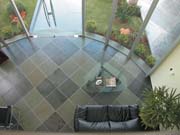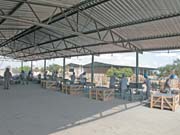
In 1988, five partners from Pompeu, Minas Gerais, Brazil, banded together to form Mineracao Capao das Pedras Ltda. (Micapel). Built from humble beginnings, three of its owners initially worked in the quarry along with five hired hands, while the other two were responsible for selling and delivering orders. Hard work proved successful for the partners of Micapel, as the company has grown to include several slate quarries and an expansive fabricating facility, which produces everything from tile and customized pieces to its new collection of mosaic borders.
The principal owners of Micapel are Leonel C. Reis, President & General Manager; Joaquim C. Reis, Business Manager; Fidel C. Reis, Machinery & Equipment Manager; Juscelino C. Reis, Plant & Milling Manager; and Avilmar O. Goncalves, Production Manager, quarrying. When the company first opened its doors, it only had several pieces of quarrying equipment that were used to produce raw slate blocks, which Micapel supplied to outside slate fabricators. Additionally, in its first year, the company operated out of a rented space in downtown Pompeu, which was equipped with two tables, a telephone and a secretary.
One year later, Micapel took its first steps towards expansion by purchasing two machines for cutting slate, a block loader, a forklift and two trucks. The company also began targeting other markets for slate tiles.
Desiring further growth, the company added a personnel and accounting department in 1990. A team of salesmen was hired and trained to work in the domestic market. Additionally, the fabrication facility was expanded to include a maintenance shop, a spare parts and supply shed, and a cafeteria. New trucks were also acquired.

A diversity of slate
The first quarry that Micapel had acquired in 1988, which was named Original, is a source of gray and multicolor slate. A second site, Capao do Mato, was opened in 1991. This quarry yields Montauk Blue, a graphite-like gray slate, and Rusty slate, which is multicolor. There are currently 65 workers at this site, producing 18,600 tons of material per month, according to Micapel. Machinery in operation at the quarry includes 16 saws, six loaders and four trucks. After acquiring this site, Micapel increased sales of raw blocks and paving tiles in the domestic market.A third quarry, Matacao, was put into operation in 2000. This site yields a very hard, compact and non-splitting gray slate called Diamond Gray. With 20 workers on site, this quarry yields 2,400 tons of slate per month. The site is equipped with five saws, three loaders and two trucks.
The following year, Micapel opened another quarry site, Martinho Campos, which produces Montauk Black, a graphite black slate, and Blackberry, a coal-black slate. There are 34 workers at this quarry, and the yield is 4,400 tons per month, reports Micapel. The site includes eight saws, four loaders and two trucks.
Pompeu Velho, a quarry acquired in 2002, also is a source for Montauk Black and Blackberry slate. This site operates with 30 workers, 10 saws, five loaders and two trucks. It produces a total of 12,700 tons of slate per month.
Micapel also operates Felixlândia I & II, two quarries that were acquired along with a manufacturing plant, when the company received the majority of stock in the company Green Slate Mining in 2000. The quarries produce a number of purple and green varieties of slate. These include: Burgundy, a dark purple; Rose, a pale purple; Jungle Green, a dark green; Jade Green, a pale green; Greenwitch, a blend of purple and green; and Verdigris, a blend of light green and purple. There are 15 workers at this quarry site, and it yields 6,800 tons of material per month. Equipment includes six saws, three loaders and two trucks.
In 2003, Micapel created a geology department for assessing existing quarries and prospecting for new ones. This was coupled with a Petrology Study Center.
Improving fabrication
As its yield from the quarries continued to increase, Micapel decided it was time to improve upon its production facility. As a result, the company established a new fabrication plant in 1995, which it named Joao Vereda. This operation included state-of-the-art machinery for slate cutting, honing and gauging. The next year, the company added new milling sheds as well as several new pieces of equipment and trucks for the plant. In 1998, a roofing tile operation was set up, with machines for dressing, trimming and drilling holes.Over the years, Micapel continued to grow to meet the demands of its market. In addition to further strengthening its production capabilities at Joao Vereda, it built a plant at Três Coracões in Minas Gerais, for quartzite milling. This facility was responsible for white, yellow, greenish and brownish quartzite.
The company also started becoming more sophisticated in its production. Coming a long way from its early days, when it only produced raw blocks, Micapel began making mosaics in 2002. Advanced technology allows for the company to fabricate tiles of slate and quartzite in various sizes and shapes. The different designs can be mixed and matched to create intricately designed borders and decorative pieces.
In 2003, the company also began production of pool and billiards tabletops with state-of-the-art machines that were imported from Italy. Additionally, Micapel purchased multi-disc machines for the production of honed and calibrated slate slabs and tiles.

Expanded marketing
Due to its success in the domestic market, Micapel began testing the waters in the international market in the mid-1990s. The company participated in its first international stone exposition in 1994. In 1997, Micapel expanded its exports to the U.S. and Europe.The next year, an international division was established in Belo Horizonte, Minas Gerais, to provide better service to its customers worldwide. Today, 40% of Micapel's products are exported all over the world -- 15% of which is to the U.S. This includes paving and cladding tiles, slabs, roofing slate, cut-to-size pieces, mosaics and other elements. The other 60% of the company's business is domestic. In addition to the fabricated products, the Brazilian market also purchases raw blocks.
Micapel has supplied slate to a number of high-profile projects in the U.S. Among these are the HealthSpace museum in Cleveland, OH, which utilized more than 31,000 square feet of Green slate (see June 2004 Stone World); the Hotel Swan & Dolphin at Disney World in Orlando, FL, which was a renovation job using Montauk Blue slate; the Biomedical Engineering School at Duke University in Charlotte, NC, which used a little more than 11,000 square feet of Jade Green slate; and Virginia Commonwealth University, an ongoing project that will use 300 square meters of Montauk Black slate.
In 2000, Micapel underwent a major restructuring program to further improve its customer service department. As a result, new administration offices were built in Pompeu, Minas Gerais. The new facility, which was designed by a leading Brazilian architect, is complete with slate and quartzite throughout, modern communications and electronic systems. The company also started a Web site at: www.micapel.com, and has plans to create a showroom and product demonstration center.
Investing in its workers
Because the company also wanted to better serve its employees, an agreement was made with the local educational authorities for elementary education courses for its quarry and plant workers. Micapel built and equipped classrooms and supplied instructional materials and textbooks, while the local educational system assigned teachers for this course. Workers are now able to achieve their elementary school diplomas. This program was later expanded to include junior high school. The project is designed to eventually further expand to include senior high school classes.Moreover, Micapel designed and implemented a program for work safety and medical care for all quarry and plant workers. In 2002, a dental care center was set up and equipped with modern equipment and materials, including an X-ray machine, and dentists were contracted to serve quarry and plant workers at no cost. Additionally, recent plans to further expand upon employee benefits include new facilities for sports, such as a soccer field, three multi-purpose courts, and leisure and television rooms.
